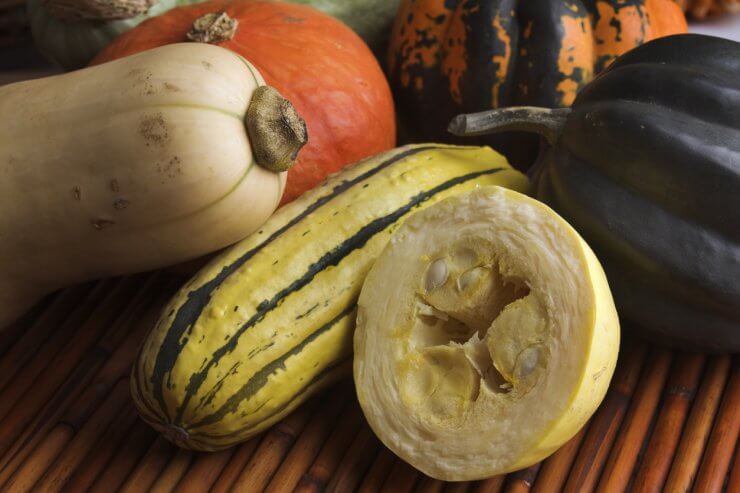
A variety winter squash
If you ask someone to name familiar types of squash, they’ll probably say acorn, butternut, and spaghetti. Butternut squash is the most popular squash crop in the United States. But there are so many other squashes than what you see at the supermarket.
Squash are part of the genus Cucurbitaceae—the gourd family. This includes ornamental gourds, loofahs, pumpkins, summer squash, and more winter squash than you can read off in one breath. The squash we grow for food come from three species: Cucurbita pepo, C. moschata, and C. maxima. Pumpkins are included in these species, but since they have their own broad spectrum, we have a separate Pumpkin Collection that you can read at your leisure.
Here’s an overview of the types of winter squash common among home gardeners. We’ve divided them here by species, just so you can see the basic breakdown and broad variety.
Acorn (C. Pepo) Vining & Bush Varieties
- Cream of the Crop
- Ebony
- Swan White
- Table Ace
- Table Gold
- Table King
- Table Queen
- Tay-Belle
Delicata (C. Pepo) Vining & Bush Varieties
- Delicata
- Honey Boat
- Sugar Loaf
- Sweet Dumpling
Spaghetti (C. Pepo) Vining & Bush Varieties
- Orangetti
- Pasta
- Stripetti
- Tivoli
- Vegetable Spaghetti
Butternut (C. Moschata) Vining
- Butterbush
- Early Butternut
- Ponca
- Puritan
- Supreme
- Ultra
- Waltham
- Zenith
“True” Winter Squash (C. maxima)
- All Season
- Banana
- Buttercup
- Delicious
- Emerald Bush Buttercup
- Honey Delight
- Gold Nugget
- Baby, Blue, Chicago, Golden, Green and Warted Hubbard
- Mooregold
- Sweet Mama
- Sweet Meat
- Red Kuri
Now, if you’re a food gardener who’s more interested in the features of a given squash rather than its classification, here’s a sampling of some of the most popular winter squash you’re likely to see in a home garden.
Acorn Squash:
- Small, round squash with a dull green rind and yellow-orange flesh
- Stores whole for about a month
- Bake, roast, steam, or microwave
- Good for halving and stuffing
Banana Squash:
- Orange, pink, or blue skin with orange flesh
- Can weigh up to 35 pounds
- Whole squash can last up to six months in cold storage
- Good roasted with bold spices
Buttercup Squash:
- Dark green with round ridges at the bottom
- Stores whole up to three months
- Bright orange flesh that’s mild and sweet
Carnival Squash:
- A cross between acorn and sweet dumpling squash; has deep furrow and bright stripes
- Stores whole up to three months
- Roast or use in soup
Delicata Squash:
- Also called Bohemian, Sweet Potato Squash
- Cylindrical with yellow skin and green stripes
- Stores up to three months
- Tastes like sweet potato when cooked
- Stuff, roast, steam, or microwave
- Skin is edible
Hubbard Squash:
- Big and bumpy, with very hard orange, green, or gray-blue skin
- Sweet orange flesh
- Stores whole up to six months
- Peel before cooking
- Mash or puree and make into pie
- Also good steamed, boiled, or roasted
Kabocha Squash:
- Small, squat, with dark green skin
- Sweet orange flesh that tastes like pumpkin and sweet potato
- Store whole for up to a month
- Popular in Japan for making tempura
- Works well as a soup thickener
Spaghetti Squash:
- Pale to bright yellow skin—the brighter the skin, the riper the squash
- Stores whole for several weeks
- Bake or steam
- Great low-calorie alternative to pasta
You’ll find a huge variety of squash seeds at seed companies and garden centers. Ask your local extension center which type of squash is best suited for your gardening conditions.
Which type of winter squash have you grown? Do you have a preference? Please share your opinion.


 Previous
Previous


I would like to see what each of these varieties look like.
Never mind. I just needed to look further down on the table of contents????????♀️